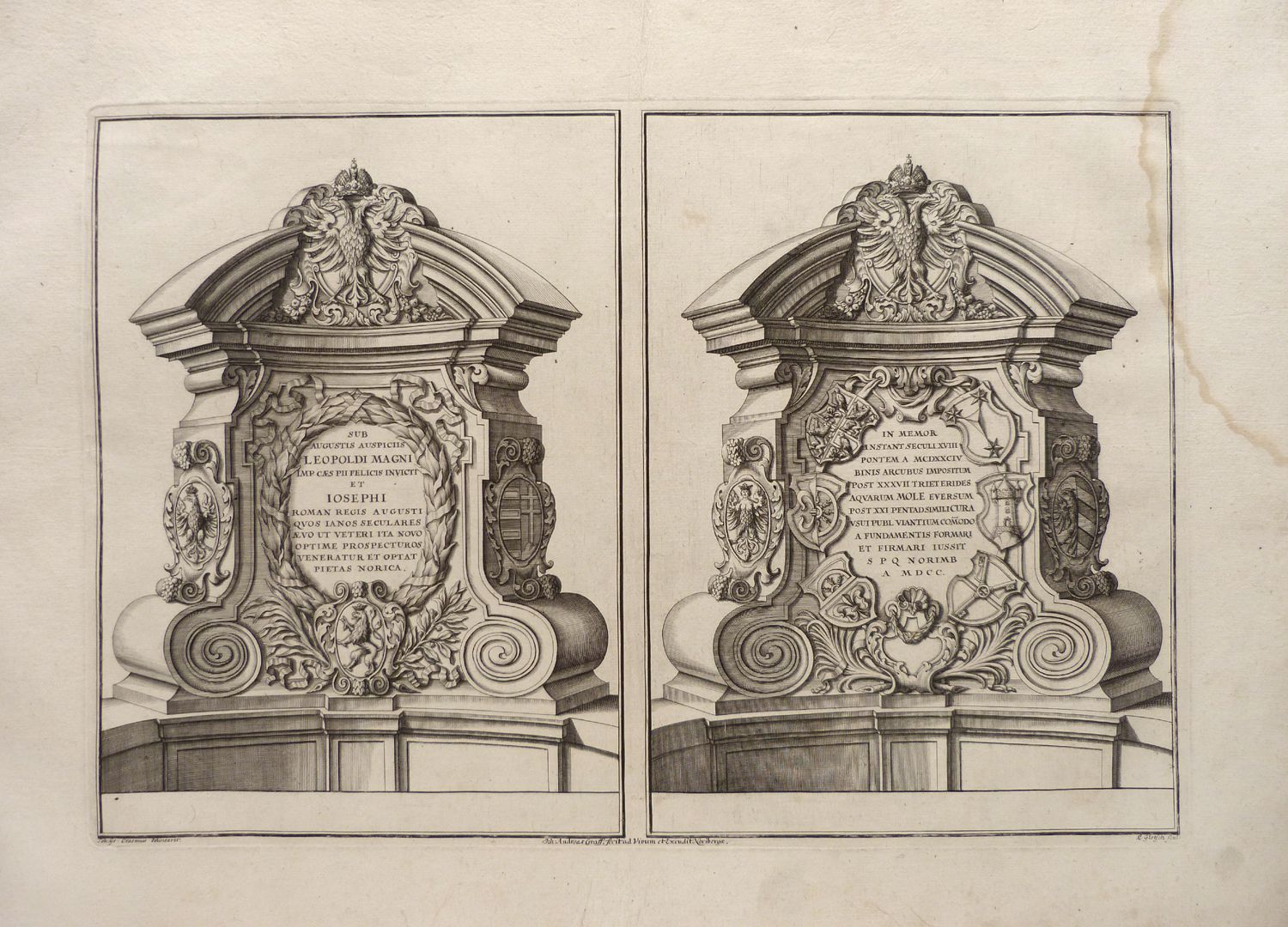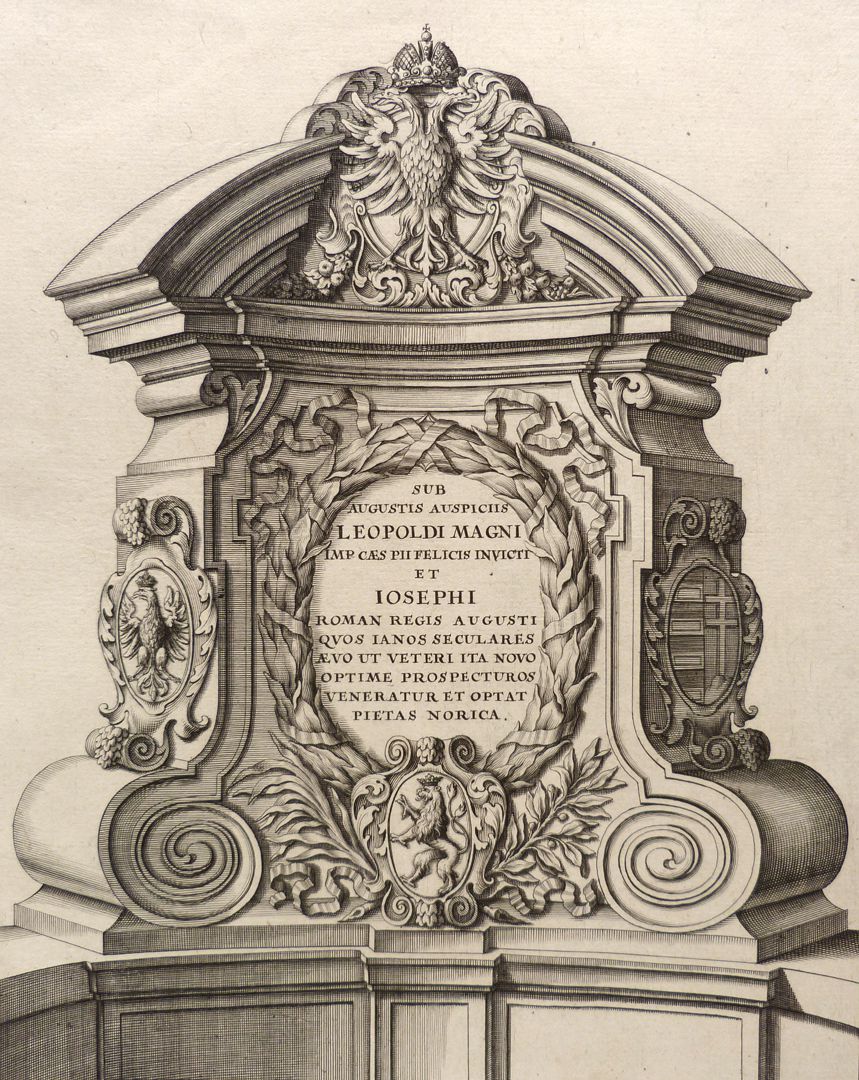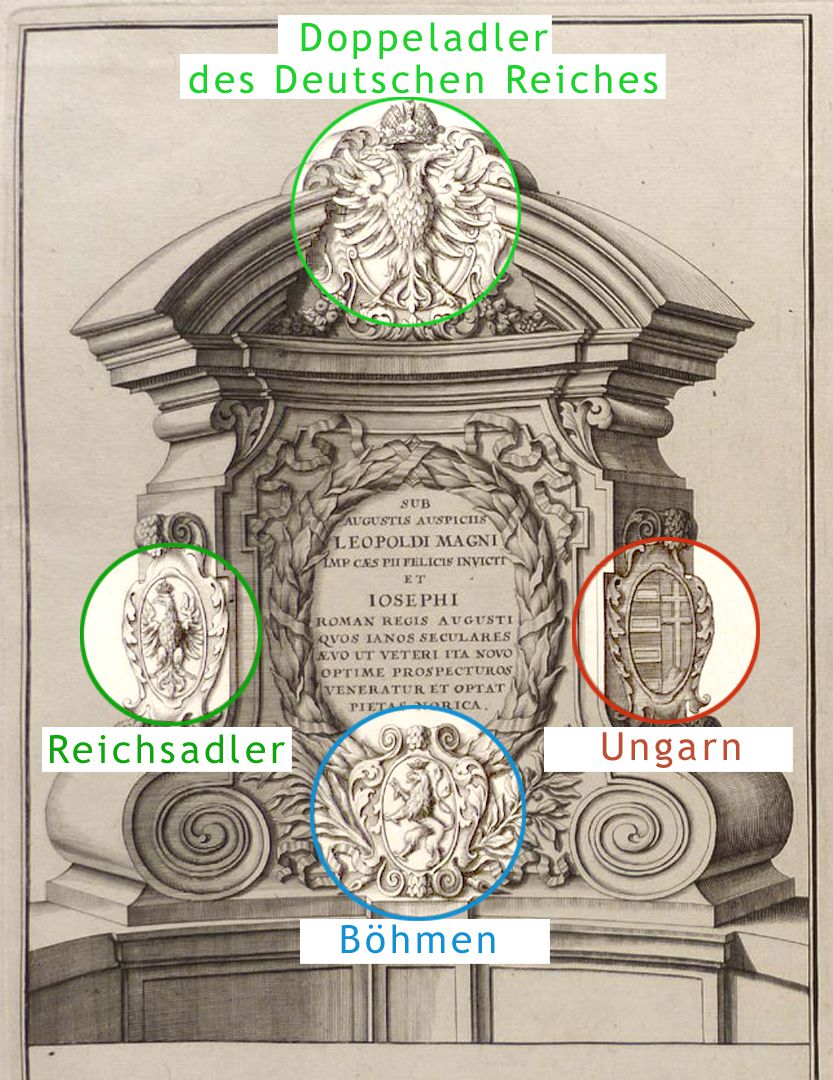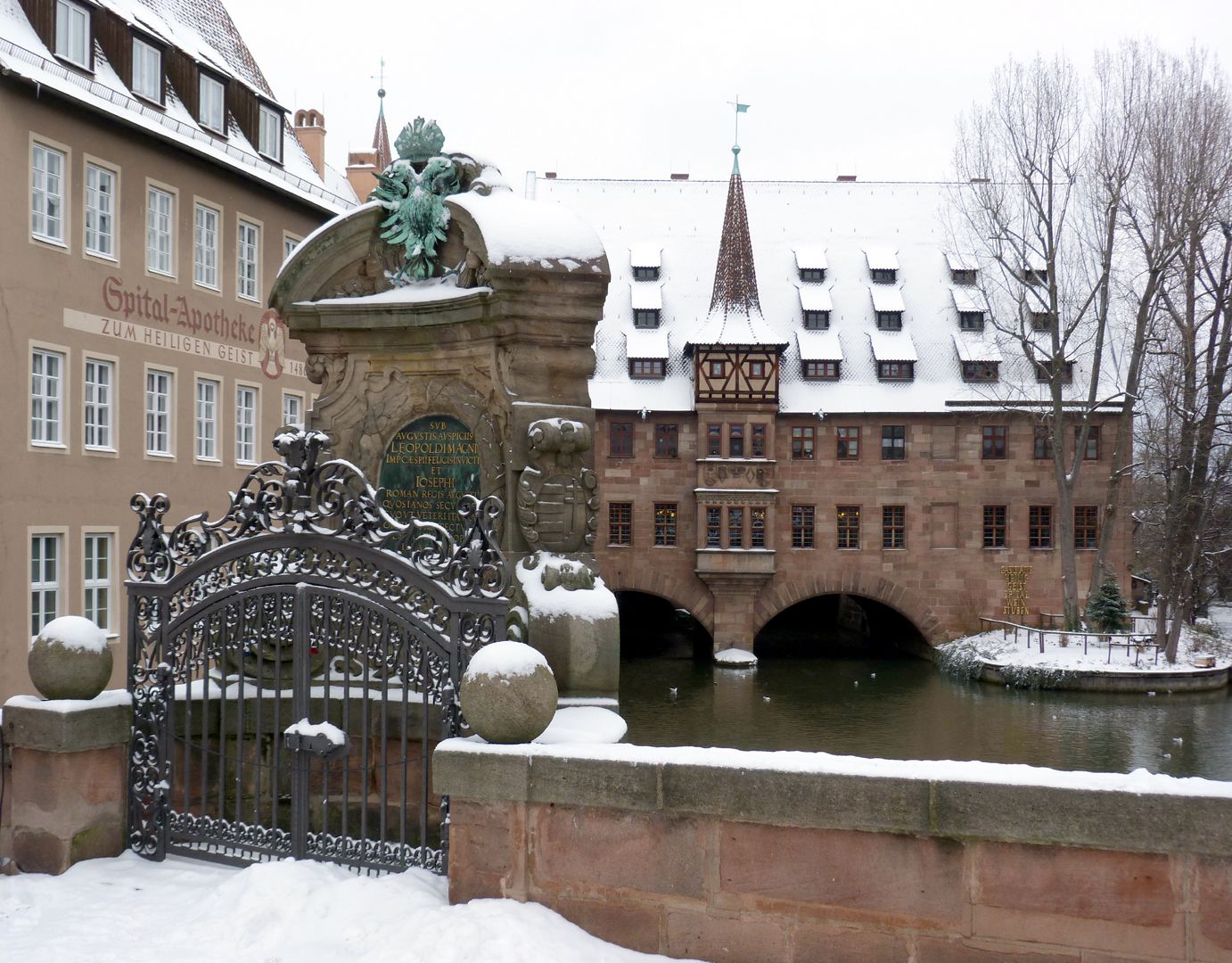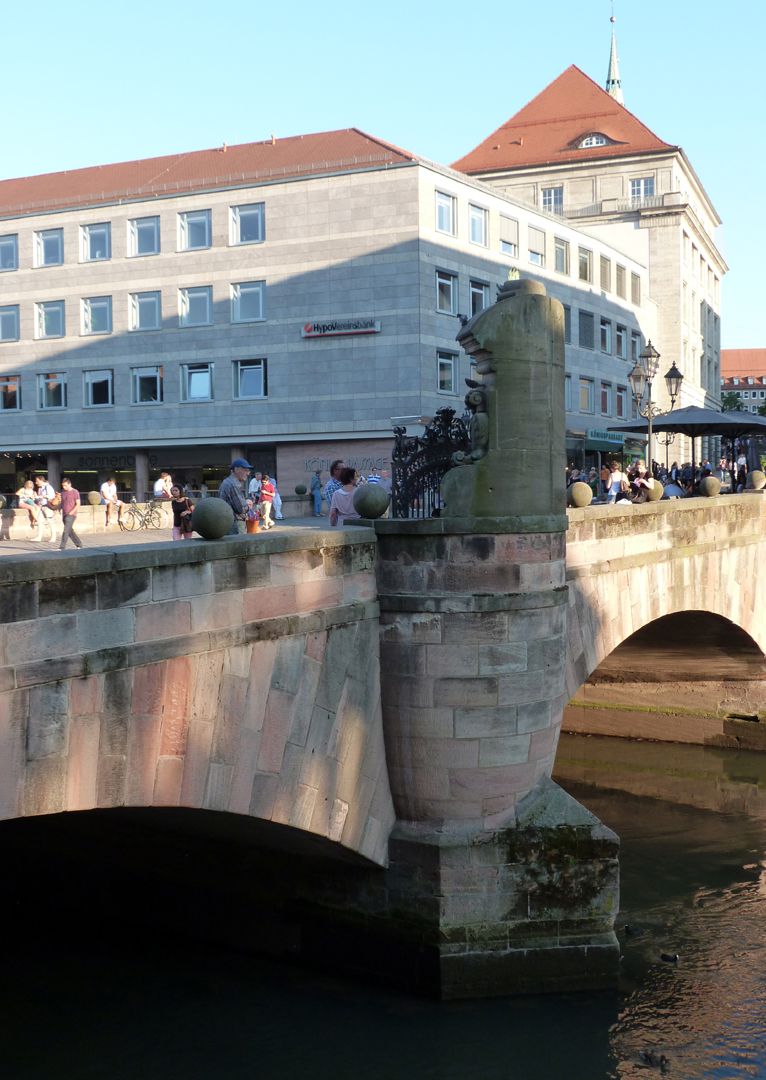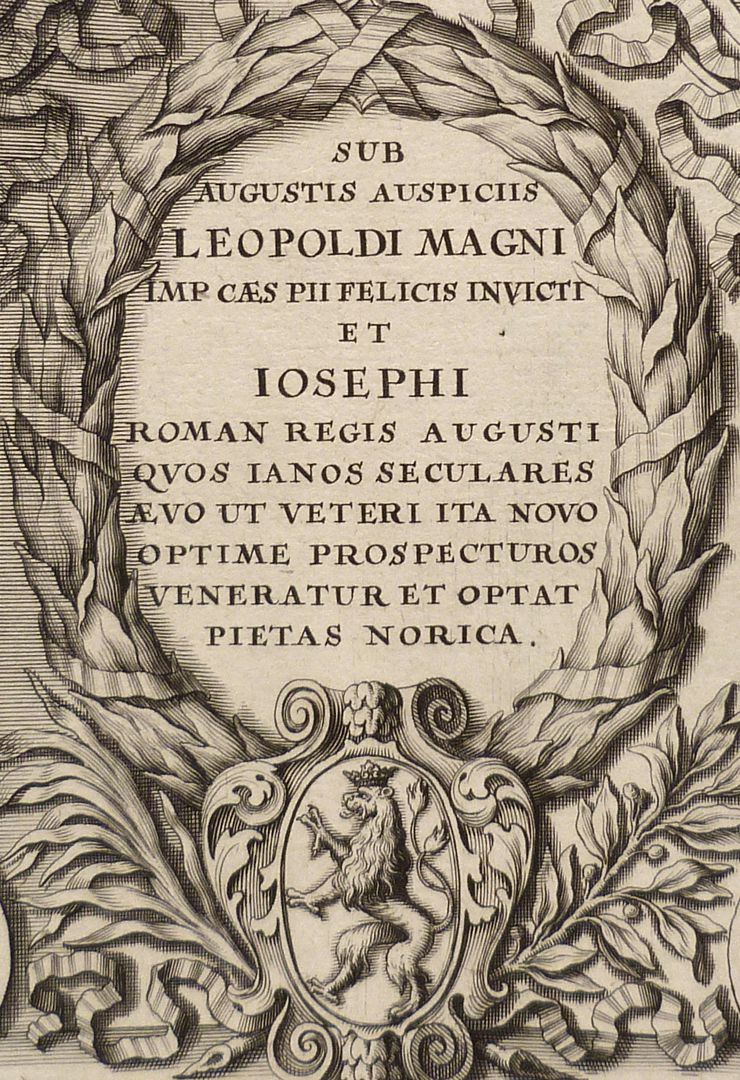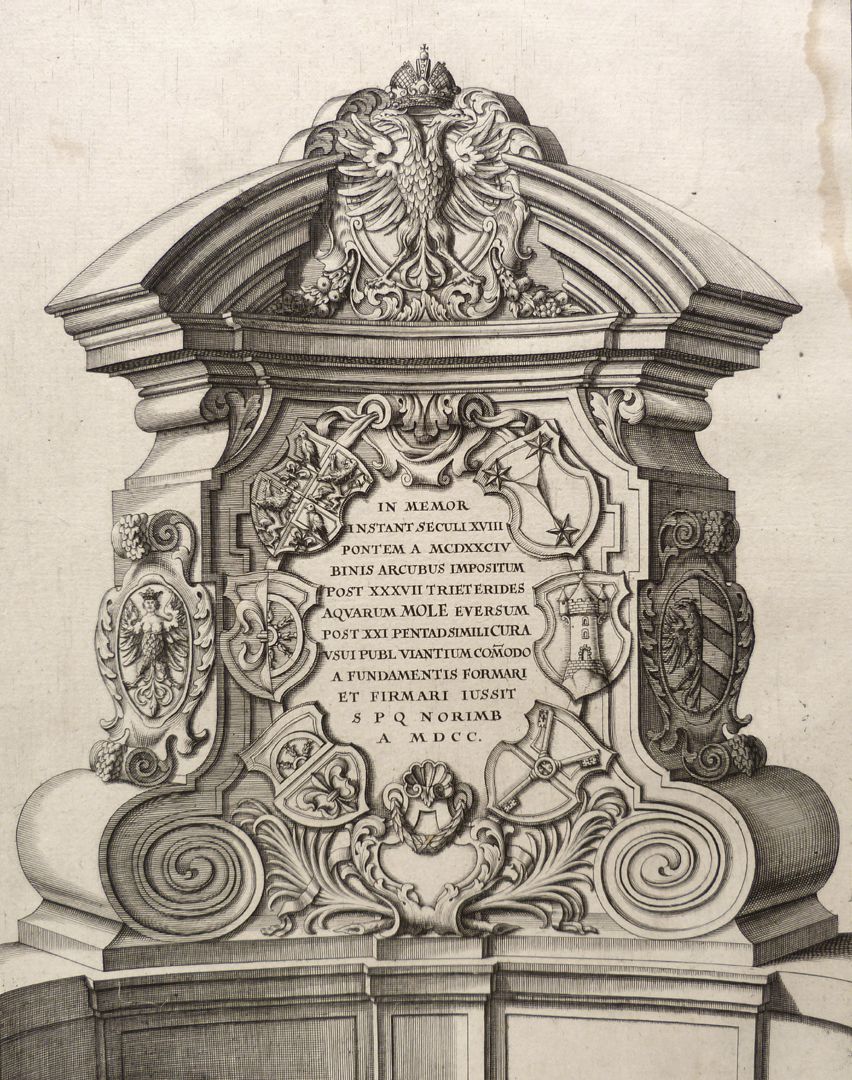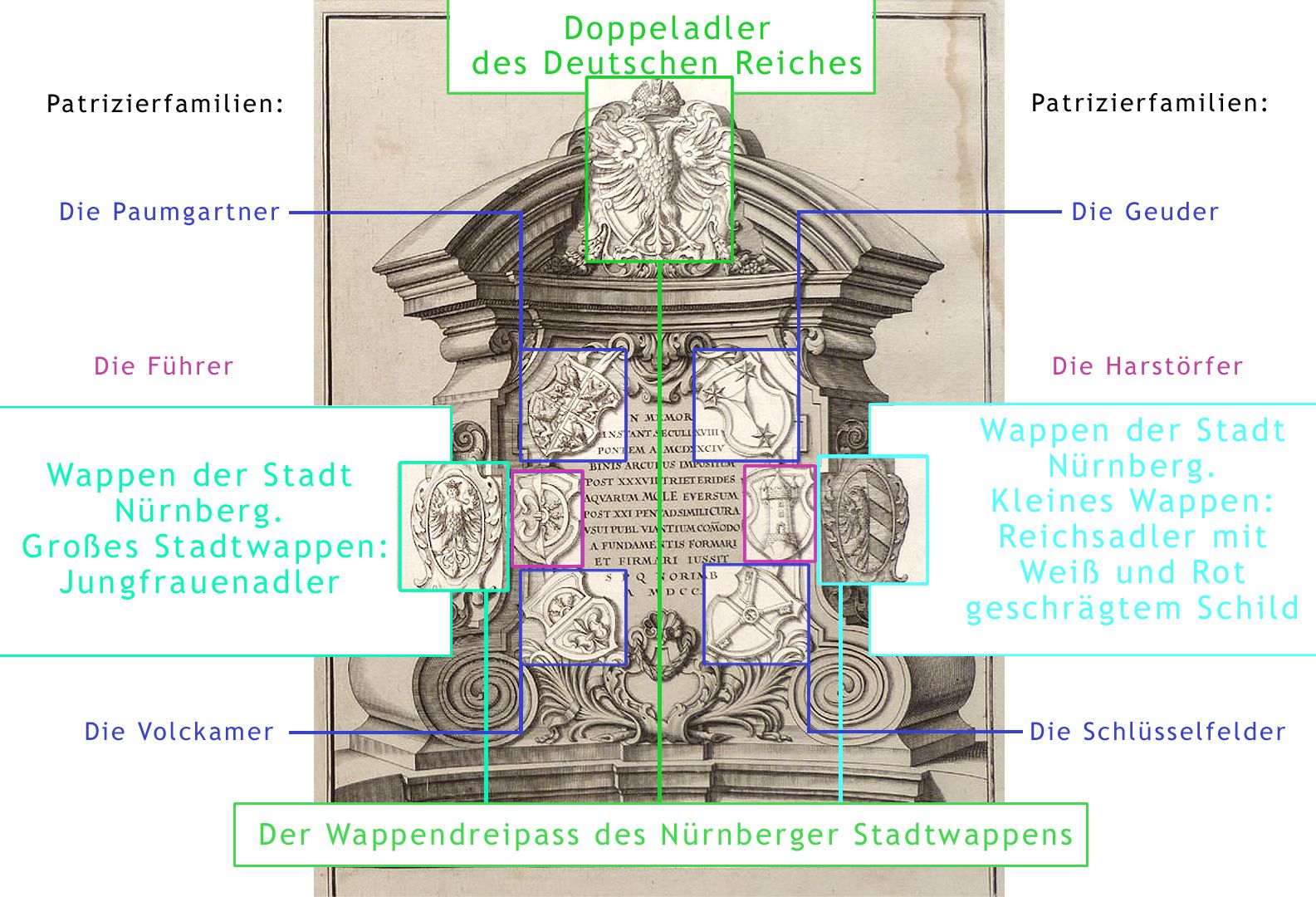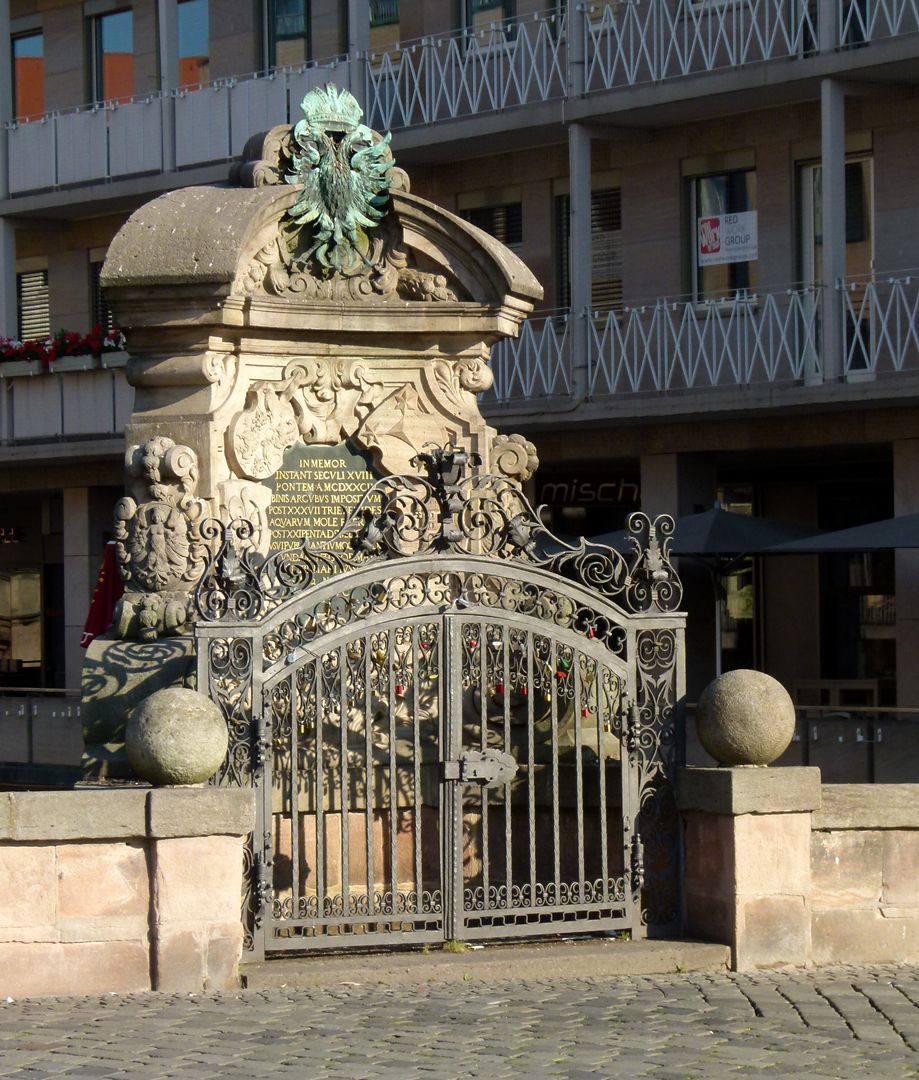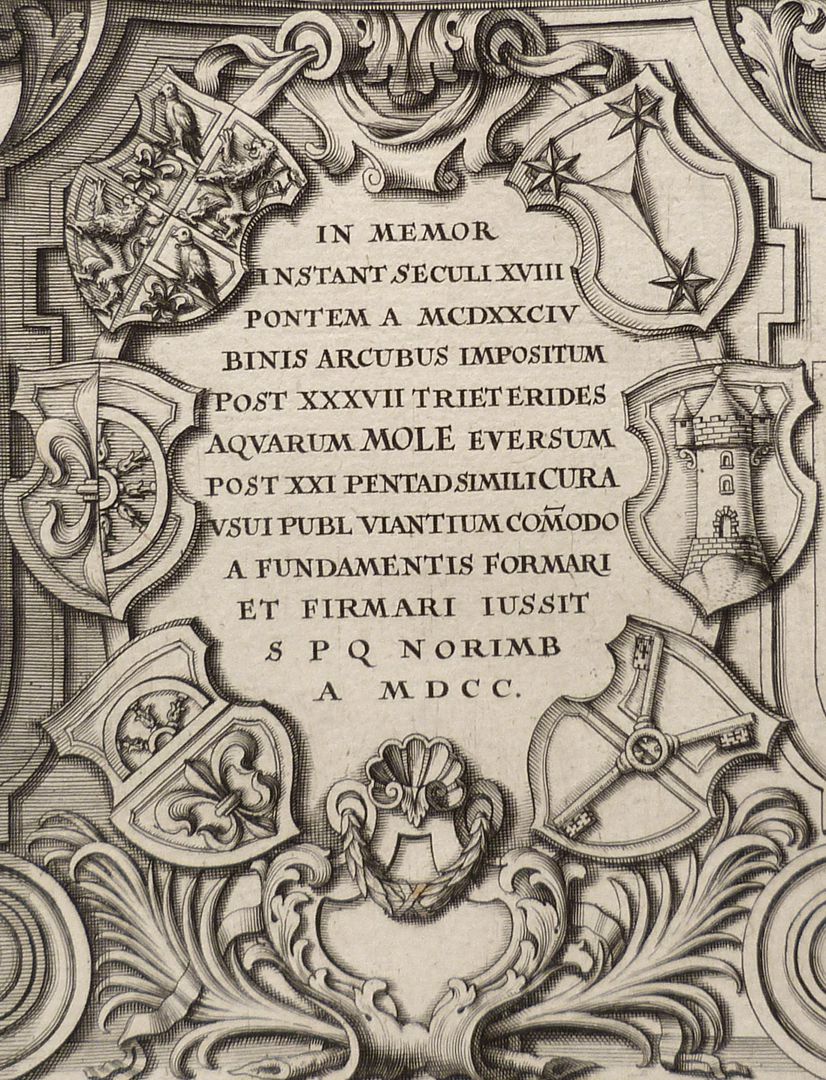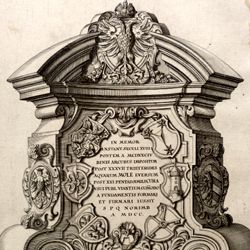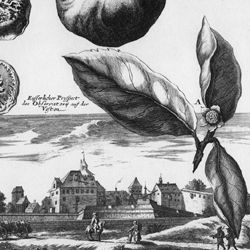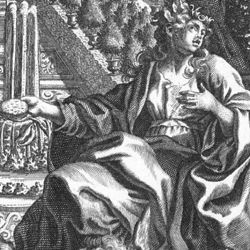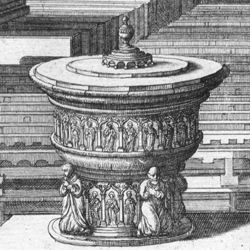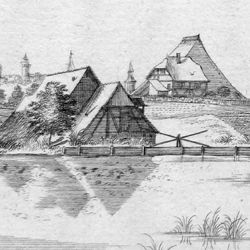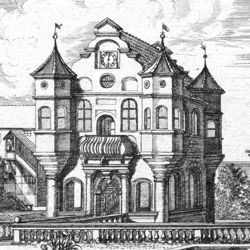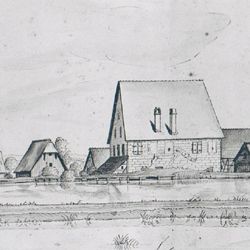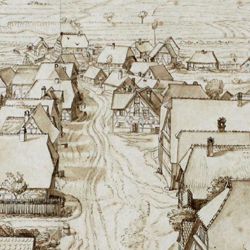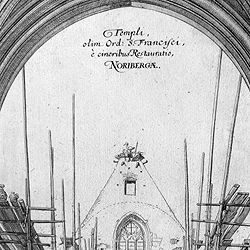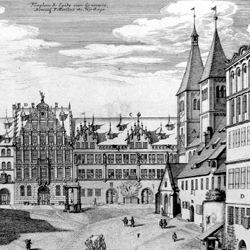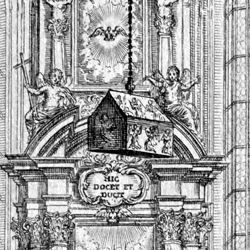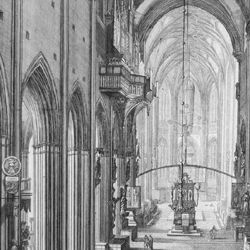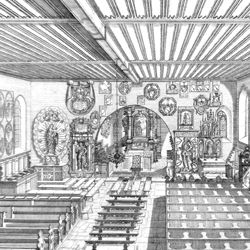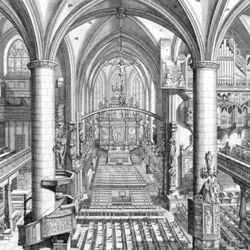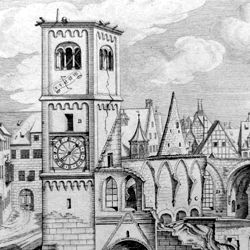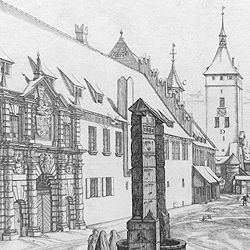Pulpits of the Museum Bridge with inscriptions
Pulpits of the Museum Bridge with inscriptions
1700
Graphic representation of the two pulpits (laterally extended area) of the Museum Bridge in Nuremberg.
(Design) Erasmus, Johann Georg:
delineavit = he drew it
(print and publisher) Johann Andreas Graff:
fecit ad vivum = he made after life (as it is).
(engraver) Glotsch, (Johann) Ludwig Christoph:
sculpsit = engraved it
Johann Georg Erasmus, since 1698 Anschicker on the Peunt and anyway well known as an architectural draughtsman, might have been the designer of the two pulpits, so that "delineavit" might refer to the draughtsman's design of the pulpits themselves.
(Helge Weingärtner)
The inscription panels were placed in honour of Emperor Leopold I and King Joseph I, which also gave rise to the names "Josephsbrücke" (Joseph Bridge) and "Königsbrücke" (King's Bridge), which, however, did not become established. Furthermore, there are panels with the coats of arms of the Holy Roman Empire, the kingdoms of Hungary and Bohemia, the Nuremberg coat of arms triple pass and the coats of arms of the highest-ranking councillors.
(Margot Lölhöffel)
Location: private
Realization: Glotsch, (Johann) Ludwig Christoph, Graff, Johann Andreas
photo 2018, Theo Noll
Pulpits of the Museum Bridge with inscriptions
1700
East pulpit
Graphic representation of the two pulpits (laterally extended area) of the Museum Bridge in Nuremberg.
(Design) Erasmus, Johann Georg:
delineavit = he drew it
(print and publisher) Johann Andreas Graff:
fecit ad vivum = he made after life (as it is).
(engraver) Glotsch, (Johann) Ludwig Christoph:
sculpsit = engraved it
Johann Georg Erasmus, since 1698 Anschicker on the Peunt and anyway well known as an architectural draughtsman, might have been the designer of the two pulpits, so that "delineavit" might refer to the draughtsman's design of the pulpits themselves.
(Helge Weingärtner)
The inscription panels were placed in honour of Emperor Leopold I and King Joseph I, which also gave rise to the names "Josephsbrücke" (Joseph Bridge) and "Königsbrücke" (King's Bridge), which, however, did not become established. Furthermore, there are panels with the coats of arms of the Holy Roman Empire, the kingdoms of Hungary and Bohemia, the Nuremberg coat of arms triple pass and the coats of arms of the highest-ranking councillors.
(Margot Lölhöffel)
Location: private
Realization: Glotsch, (Johann) Ludwig Christoph, Graff, Johann Andreas
photo 2018, Theo Noll
Pulpits of the Museum Bridge with inscriptions
1700
East pulpit with coat of arms
Graphic representation of the two pulpits (laterally extended area) of the Museum Bridge in Nuremberg.
(Design) Erasmus, Johann Georg:
delineavit = he drew it
(print and publisher) Johann Andreas Graff:
fecit ad vivum = he made after life (as it is).
(engraver) Glotsch, (Johann) Ludwig Christoph:
sculpsit = engraved it
Johann Georg Erasmus, since 1698 Anschicker on the Peunt and anyway well known as an architectural draughtsman, might have been the designer of the two pulpits, so that "delineavit" might refer to the draughtsman's design of the pulpits themselves.
(Helge Weingärtner)
The inscription panels were placed in honour of Emperor Leopold I and King Joseph I, which also gave rise to the names "Josephsbrücke" (Joseph Bridge) and "Königsbrücke" (King's Bridge), which, however, did not become established. Furthermore, there are panels with the coats of arms of the Holy Roman Empire, the kingdoms of Hungary and Bohemia, the Nuremberg coat of arms triple pass and the coats of arms of the highest-ranking councillors.
(Margot Lölhöffel)
Location: private
Realization: Glotsch, (Johann) Ludwig Christoph, Graff, Johann Andreas
photo 2018, Theo Noll
Pulpits of the Museum Bridge with inscriptions
1700
Eastern pulpit, view of the place
Graphic representation of the two pulpits (laterally extended area) of the Museum Bridge in Nuremberg.
(Design) Erasmus, Johann Georg:
delineavit = he drew it
(print and publisher) Johann Andreas Graff:
fecit ad vivum = he made after life (as it is).
(engraver) Glotsch, (Johann) Ludwig Christoph:
sculpsit = engraved it
Johann Georg Erasmus, since 1698 Anschicker on the Peunt and anyway well known as an architectural draughtsman, might have been the designer of the two pulpits, so that "delineavit" might refer to the draughtsman's design of the pulpits themselves.
(Helge Weingärtner)
The inscription panels were placed in honour of Emperor Leopold I and King Joseph I, which also gave rise to the names "Josephsbrücke" (Joseph Bridge) and "Königsbrücke" (King's Bridge), which, however, did not become established. Furthermore, there are panels with the coats of arms of the Holy Roman Empire, the kingdoms of Hungary and Bohemia, the Nuremberg coat of arms triple pass and the coats of arms of the highest-ranking councillors.
(Margot Lölhöffel)
Location: private
Realization: Glotsch, (Johann) Ludwig Christoph, Graff, Johann Andreas
photo 2014, Theo Noll
Pulpits of the Museum Bridge with inscriptions
1700
Eastern pulpit, side view and view of the place
Graphic representation of the two pulpits (laterally extended area) of the Museum Bridge in Nuremberg.
(Design) Erasmus, Johann Georg:
delineavit = he drew it
(print and publisher) Johann Andreas Graff:
fecit ad vivum = he made after life (as it is).
(engraver) Glotsch, (Johann) Ludwig Christoph:
sculpsit = engraved it
Johann Georg Erasmus, since 1698 Anschicker on the Peunt and anyway well known as an architectural draughtsman, might have been the designer of the two pulpits, so that "delineavit" might refer to the draughtsman's design of the pulpits themselves.
(Helge Weingärtner)
The inscription panels were placed in honour of Emperor Leopold I and King Joseph I, which also gave rise to the names "Josephsbrücke" (Joseph Bridge) and "Königsbrücke" (King's Bridge), which, however, did not become established. Furthermore, there are panels with the coats of arms of the Holy Roman Empire, the kingdoms of Hungary and Bohemia, the Nuremberg coat of arms triple pass and the coats of arms of the highest-ranking councillors.
(Margot Lölhöffel)
Location: private
Realization: Glotsch, (Johann) Ludwig Christoph, Graff, Johann Andreas
photo 2014, Theo Noll
Pulpits of the Museum Bridge with inscriptions
1700
Inscription on the eastern pulpit
Graphic representation of the two pulpits (laterally extended area) of the Museum Bridge in Nuremberg.
(Design) Erasmus, Johann Georg:
delineavit = he drew it
(print and publisher) Johann Andreas Graff:
fecit ad vivum = he made after life (as it is).
(engraver) Glotsch, (Johann) Ludwig Christoph:
sculpsit = engraved it
Johann Georg Erasmus, since 1698 Anschicker on the Peunt and anyway well known as an architectural draughtsman, might have been the designer of the two pulpits, so that "delineavit" might refer to the draughtsman's design of the pulpits themselves.
(Helge Weingärtner)
The inscription panels were placed in honour of Emperor Leopold I and King Joseph I, which also gave rise to the names "Josephsbrücke" (Joseph Bridge) and "Königsbrücke" (King's Bridge), which, however, did not become established. Furthermore, there are panels with the coats of arms of the Holy Roman Empire, the kingdoms of Hungary and Bohemia, the Nuremberg coat of arms triple pass and the coats of arms of the highest-ranking councillors.
(Margot Lölhöffel)
Location: private
Realization: Glotsch, (Johann) Ludwig Christoph, Graff, Johann Andreas
photo 2018, Theo Noll
Pulpits of the Museum Bridge with inscriptions
1700
West pulpit
Graphic representation of the two pulpits (laterally extended area) of the Museum Bridge in Nuremberg.
(Design) Erasmus, Johann Georg:
delineavit = he drew it
(print and publisher) Johann Andreas Graff:
fecit ad vivum = he made after life (as it is).
(engraver) Glotsch, (Johann) Ludwig Christoph:
sculpsit = engraved it
Johann Georg Erasmus, since 1698 Anschicker on the Peunt and anyway well known as an architectural draughtsman, might have been the designer of the two pulpits, so that "delineavit" might refer to the draughtsman's design of the pulpits themselves.
(Helge Weingärtner)
The inscription panels were placed in honour of Emperor Leopold I and King Joseph I, which also gave rise to the names "Josephsbrücke" (Joseph Bridge) and "Königsbrücke" (King's Bridge), which, however, did not become established. Furthermore, there are panels with the coats of arms of the Holy Roman Empire, the kingdoms of Hungary and Bohemia, the Nuremberg coat of arms triple pass and the coats of arms of the highest-ranking councillors.
(Margot Lölhöffel)
Location: private
Realization: Glotsch, (Johann) Ludwig Christoph, Graff, Johann Andreas
photo 2018, Theo Noll
Pulpits of the Museum Bridge with inscriptions
1700
West pulpit
Graphic representation of the two pulpits (laterally extended area) of the Museum Bridge in Nuremberg.
(Design) Erasmus, Johann Georg:
delineavit = he drew it
(print and publisher) Johann Andreas Graff:
fecit ad vivum = he made after life (as it is).
(engraver) Glotsch, (Johann) Ludwig Christoph:
sculpsit = engraved it
Johann Georg Erasmus, since 1698 Anschicker on the Peunt and anyway well known as an architectural draughtsman, might have been the designer of the two pulpits, so that "delineavit" might refer to the draughtsman's design of the pulpits themselves.
(Helge Weingärtner)
The inscription panels were placed in honour of Emperor Leopold I and King Joseph I, which also gave rise to the names "Josephsbrücke" (Joseph Bridge) and "Königsbrücke" (King's Bridge), which, however, did not become established. Furthermore, there are panels with the coats of arms of the Holy Roman Empire, the kingdoms of Hungary and Bohemia, the Nuremberg coat of arms triple pass and the coats of arms of the highest-ranking councillors.
(Margot Lölhöffel)
Location: private
Realization: Glotsch, (Johann) Ludwig Christoph, Graff, Johann Andreas
photo 2018, Theo Noll
Pulpits of the Museum Bridge with inscriptions
1700
West pulpit, view of the place
Graphic representation of the two pulpits (laterally extended area) of the Museum Bridge in Nuremberg.
(Design) Erasmus, Johann Georg:
delineavit = he drew it
(print and publisher) Johann Andreas Graff:
fecit ad vivum = he made after life (as it is).
(engraver) Glotsch, (Johann) Ludwig Christoph:
sculpsit = engraved it
Johann Georg Erasmus, since 1698 Anschicker on the Peunt and anyway well known as an architectural draughtsman, might have been the designer of the two pulpits, so that "delineavit" might refer to the draughtsman's design of the pulpits themselves.
(Helge Weingärtner)
The inscription panels were placed in honour of Emperor Leopold I and King Joseph I, which also gave rise to the names "Josephsbrücke" (Joseph Bridge) and "Königsbrücke" (King's Bridge), which, however, did not become established. Furthermore, there are panels with the coats of arms of the Holy Roman Empire, the kingdoms of Hungary and Bohemia, the Nuremberg coat of arms triple pass and the coats of arms of the highest-ranking councillors.
(Margot Lölhöffel)
Location: private
Realization: Glotsch, (Johann) Ludwig Christoph, Graff, Johann Andreas
photo 2014, Theo Noll
Pulpits of the Museum Bridge with inscriptions
1700
Museum bridge from the west, view of the place
Graphic representation of the two pulpits (laterally extended area) of the Museum Bridge in Nuremberg.
(Design) Erasmus, Johann Georg:
delineavit = he drew it
(print and publisher) Johann Andreas Graff:
fecit ad vivum = he made after life (as it is).
(engraver) Glotsch, (Johann) Ludwig Christoph:
sculpsit = engraved it
Johann Georg Erasmus, since 1698 Anschicker on the Peunt and anyway well known as an architectural draughtsman, might have been the designer of the two pulpits, so that "delineavit" might refer to the draughtsman's design of the pulpits themselves.
(Helge Weingärtner)
The inscription panels were placed in honour of Emperor Leopold I and King Joseph I, which also gave rise to the names "Josephsbrücke" (Joseph Bridge) and "Königsbrücke" (King's Bridge), which, however, did not become established. Furthermore, there are panels with the coats of arms of the Holy Roman Empire, the kingdoms of Hungary and Bohemia, the Nuremberg coat of arms triple pass and the coats of arms of the highest-ranking councillors.
(Margot Lölhöffel)
Location: private
Realization: Glotsch, (Johann) Ludwig Christoph, Graff, Johann Andreas
photo 2014, Theo Noll
Pulpits of the Museum Bridge with inscriptions
1700
Inscription on the west pulpit
Graphic representation of the two pulpits (laterally extended area) of the Museum Bridge in Nuremberg.
(Design) Erasmus, Johann Georg:
delineavit = he drew it
(print and publisher) Johann Andreas Graff:
fecit ad vivum = he made after life (as it is).
(engraver) Glotsch, (Johann) Ludwig Christoph:
sculpsit = engraved it
Johann Georg Erasmus, since 1698 Anschicker on the Peunt and anyway well known as an architectural draughtsman, might have been the designer of the two pulpits, so that "delineavit" might refer to the draughtsman's design of the pulpits themselves.
(Helge Weingärtner)
The inscription panels were placed in honour of Emperor Leopold I and King Joseph I, which also gave rise to the names "Josephsbrücke" (Joseph Bridge) and "Königsbrücke" (King's Bridge), which, however, did not become established. Furthermore, there are panels with the coats of arms of the Holy Roman Empire, the kingdoms of Hungary and Bohemia, the Nuremberg coat of arms triple pass and the coats of arms of the highest-ranking councillors.
(Margot Lölhöffel)
Location: private
Realization: Glotsch, (Johann) Ludwig Christoph, Graff, Johann Andreas
photo 2018, Theo Noll
Pulpits of the Museum Bridge with inscriptions
1700
Inschrift
photo 2018, Theo Noll
Graphic representation of the two pulpits (laterally extended area) of the Museum Bridge in Nuremberg.
(Design) Erasmus, Johann Georg:
delineavit = he drew it
(print and publisher) Johann Andreas Graff:
fecit ad vivum = he made after life (as it is).
(engraver) Glotsch, (Johann) Ludwig Christoph:
sculpsit = engraved it
Johann Georg Erasmus, since 1698 Anschicker on the Peunt and anyway well known as an architectural draughtsman, might have been the designer of the two pulpits, so that "delineavit" might refer to the draughtsman's design of the pulpits themselves.
(Helge Weingärtner)
The inscription panels were placed in honour of Emperor Leopold I and King Joseph I, which also gave rise to the names "Josephsbrücke" (Joseph Bridge) and "Königsbrücke" (King's Bridge), which, however, did not become established. Furthermore, there are panels with the coats of arms of the Holy Roman Empire, the kingdoms of Hungary and Bohemia, the Nuremberg coat of arms triple pass and the coats of arms of the highest-ranking councillors.
(Margot Lölhöffel)
Location: privat
Realization: Glotsch, (Johann) Ludwig Christoph, Graff, Johann Andreas
